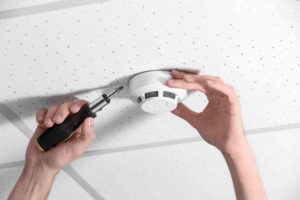
Smoke alarm placement is key to ensuring your home is protected against fires.
Smoke alarms are essential to have in every home. When properly installed, smoke alarms are the first line of defense in the event of a fire. They need to be positioned near high traffic areas of the house and any areas where the chance of a fire breaking out is the highest. With today’s modern furniture trends, smokes can spread much more quickly than in the past. Understanding the mechanics of smoke alarms can prevent terrible tragedies.
Follow the Building Code
Smoke alarms can either be hard-wired or battery-powered. Battery-operated smoke alarms do not need to be connected to the home’s electrical system. These alarms are more popular due to the low cost and easy installation, but they are only effective when the batteries are replaced on a regular basis. Unfortunately, hundreds of deaths occur each year due to smoke alarms with expired batteries. For this reason, the International Building Code requires smoke alarms to be connected to one another and wired to the home’s electrical system. When one alarm goes off, the rest will go off, thus alerting everyone in the house.
Positioning Your Smoke Alarms
The National Fire Protection Association lists these recommendations for installing smoke alarms:
- Install smoke alarms on every level of the home, inside each bedroom, outside each sleeping area, and the basement.
- On levels without bedrooms, install alarms in the living room or near the stairway to the upper level.
- Smoke alarms installed in the basement should be installed on the ceiling at the bottom of the stairs leading to the next level.
- Smoke alarms should be installed at least 10 feet (3 meters) from a cooking appliance to minimize false alarms when cooking.
- Don’t install smoke alarms near windows, doors, or ducts where drafts might interfere with their operation.
- Never paint smoke alarms. Paint, stickers, or other decorations could keep the alarms from working.
It is common for homeowners to install smoke alarms on the ceiling, but installing alarms high up on the wall is more effective. This is because some types of fire will fill the ceiling areas with chemical gases that push the smoke downward slightly. By positioning the smoke alarms at about 12 inches below the ceiling, you can ensure that they will detect smoke as early as possible. When renovating or adding on to your home, be sure to consult the building codes for your area to ensure that your home is properly protected.
Commercial and Residential Fire Prevention from Judd Fire Protection
If you want to ensure your home and business are safe throughout the year, trust Judd Fire Protection, LLC. We have over two decades of experience designing, installing, inspecting, and repairing residential and commercial fire protection systems. We serve clients throughout Maryland, Pennsylvania, Washington, D.C., Virginia, and West Virginia. If you are interested in finding out more about our services and protecting your home and business, give us a call at 410-871-3480 or contact us online. For more fire safety tips, follow us on Facebook, Twitter, and Pinterest.
